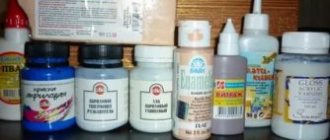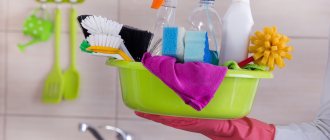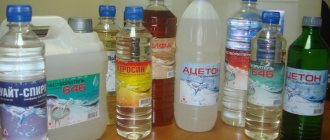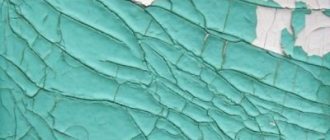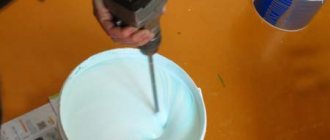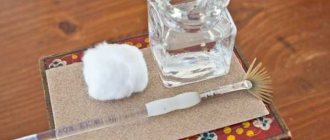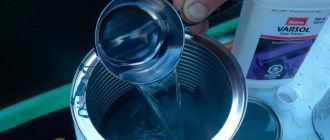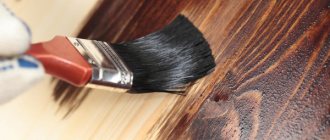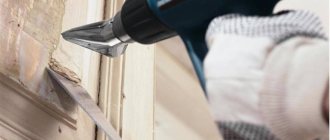Compound
Any paint based on water-dispersed materials consists of:
- 50% or more foaming agent;
- 37% fillers;
- 7% - plasticizers;
- 6% various impurities.
The versatility of water-based materials cannot but rejoice, because the same brand can be used for external and internal work. This was one of the factors behind the widespread use of water-dispersion paints. In addition to their use for all weather conditions and humidity, it is worth noting that they are also suitable for completely different types of surfaces. The thing is that such a material consists of pigments and binders.
Classification of water-based dye by composition
Water-based paint is divided into 4 types based on the polymer, which is considered the basis of the dye:
- Composition: acrylic . Components: acrylic resins, various additives that form the technological qualities of CM. For example, the addition of lactose increases the tolerance of high humidity to the painted surface. Acrylic dye is applied to concrete, metal, wood, plastic and glass surfaces. KM dries quickly and there is no unpleasant smell in the room.
- Silicone composition. Widely used despite the high price. Can be applied to a damp surface, the coating is vapor permeable. Irregularities on the wall up to 2 mm can be easily eliminated.
- Water-emulsion silicate CM. This is a tandem of water emulsion and liquid glass. The coating reduces excess humidity in the room by absorbing it. When the humidity level drops, it releases it back. Paint is often applied to external surfaces because it can withstand weather conditions.
- Mineral composition of water emulsion. The constituent elements are cement or slaked lime. Concrete, brick and plaster are coated with the composition. CM is distinguished by its tolerance to sunlight, humidity, and chemical exposure.
Main types
There are several types of water-based paints:
- Based on polyvinyl acetate. They contain PVA glue. The cost of this type of paint is the lowest. The color palette is limited and stability is low.
- Paints based on liquid glass and a special pigment (silicate). Used for external and internal work. The downside is their low resistance to moisture. Silicate paints must be used with extreme caution, as they contain alkalis that can cause irritation to the skin and mucous membranes. Work with such materials is carried out in protective suits.
- Paints based on silicone resins. They are called silicone. There is a certain proportion of silicone resin in the paint, the other part of the composition is water. Silicone materials are considered the most commonly used.
- Paints containing acrylic resins can provide additional strength and elasticity. This type of material has the highest resistance to wear and moisture. Their cost will also be higher than that of the types of paints given above. Acrylic or latex materials are the most popular of water-dispersed ones. The painted surface with latex paint can be washed, and acrylic will protect the surface from mechanical damage. An interesting fact confirming the high quality of latex-based paints is that two layers of this material can hide a 1 mm thick crack.
Paint removal methods
There are several options for removing water-based paint. Which one is right for you depends on where, to what extent and for how long the unwanted stains are located, as well as the availability of suitable materials.
When choosing a method, it is important to consider that some of them can damage the stained surface. To prevent this from happening, follow our instructions exactly.
Removing paint from the surface using a spatula
This option is suitable for removing old water-based paint from the ceiling or walls before applying a new coating or when using other finishing materials, for example, when using wallpaper in the future.
Attention! This method is not suitable for removing paint stains from parquet, linoleum, lacquered furniture or painted plank floors, as it may ruin its appearance.
Materials you will need: water at room temperature, a clean and absorbent roller or large sponge, spatula, oilcloth or newspaper to protect the surface, safety glasses.
Paint removal process:
- If you are cleaning a wall or ceiling, remove all furniture from the room and cover the floor with plastic sheeting or newspaper.
- Wet the surface to be treated generously with water using a roller or sponge.
- Leave the water-based paint stains to soak for 20 minutes.
- Remove the paint with a spatula.
Removing old stains
If you need to scrub away stubborn stains, you can use a steel wool pad, however, this method is not suitable for all surfaces.
Here is an example of how to remove old water-based paint from delicate materials:
Materials for removing water-based paint: hot water, washing powder, dishwashing sponge, dry rag.
How to remove old stains:
- Dissolve a small amount of powder in water.
- Wet the stained areas with a large amount of solution (you must literally squeeze a sponge soaked in soapy water onto the stain).
- Leave the paint to soak for 30-40 minutes.
- Remove the stain with the rough side of the sponge.
- Wash the cleaned surface with water.
- Blot off excess moisture with a rag.
Attention! If you have stained a parquet floor coated with a special oil, do not soak the stains on it for more than 2-3 minutes because the oil does not protect the wood from prolonged exposure to moisture.
In this case, clean the floor in several approaches, between which wipe the damp areas dry.
Removing paint using solvents
When the paint has become so deeply embedded that none of the methods described above helps, solvents come to the rescue.
There are special preparations for washing off water-based paint; they can be purchased at hardware stores and construction markets. Instructions for their use are often written on the packaging.
If buying expensive drugs is not part of your plans, you can use regular acetone or nail polish remover, or formic acid.
Materials needed for this method: acetone, dish sponge, large piece of cotton wool, rubber gloves, respiratory protective mask, rag, water, soap solution.
Process for removing stains with acetone:
- Clean the stain with as much soap and water as possible.
- Rinse the area to be treated with clean water and wipe it dry.
- Soak some cotton wool in acetone and rub the remaining stain thoroughly.
- Rinse off the acetone with clean water.
- Ventilate the room.
Attention! The fumes from some solvents are very toxic, so be sure to wear protective gloves and a mask when working with them.
Removing paint using a sander
When you stain your parquet floor with water-based paint and cannot wipe it off using any of the previously described methods, you will have to remove the top layer of parquet using a sanding machine.
For this method you will need: a grinding machine, water, soap solution, a rag, a sponge, a mask to protect the respiratory tract, a broom, a rubber spatula.
The procedure for removing stubborn water-based paint using a grinding machine:
- Remove all furniture from the room.
- Clean off the whitewash as much as possible using a spatula and soap solution.
- Sweep and dry the floor.
- Plug in the sander and run it evenly across the floor.
- Sweep up any resulting wood dust.
- If traces of paint remain, repeat the procedure again.
- Wash the floor with clean water.
- Ventilate the room.
How to dilute water-based paint?
If a can of paint is left for a while, for example if it is leftover from painting something, it will thicken over time. This is due to a decrease in moisture in its composition, due to which elasticity and the ability to evenly cover surfaces are lost. How and with what can you dilute water-based paint?
It can be diluted with water, since it is a component of any such material. Due to the evaporation of water, the paint loses its original properties. But this can be easily fixed by adding regular drinking water to the jar and stirring it well using a construction mixer.
You can dilute it in a jar or clean bucket. You need to pour in the paint and water gradually, stirring constantly until you get the desired consistency. If it is necessary to give a certain color, then use color scheme. A certain amount of a dye of a suitable color is diluted in a small container with water-based paint. After this, the contents are gradually poured into a bucket with already diluted material until it reaches the desired shade.
Features of water emulsion
Before you start diluting water-based paint, it is worth finding out what such a composition is. Water-based paint is a paint and varnish material with excellent environmental characteristics. The binding component of this composition is water, with which the paint is diluted before use. That is why it can be safely applied to the wall and the base of the ceiling, since the composition is suitable for finishing the room and the interior of the building. The advantages of water-based paints are:
- the ability to paint any type of surface (concrete, wallpaper, wood, drywall);
- environmentally friendly composition, which does not contain substances harmful to health, endowed with a persistent aroma;
- durability - the product will not crumble or crack over time.
Such positive aspects are considered significant when choosing paint for a ceiling or wall covering. But is it necessary to dilute the composition with special solvents or water?
How to apply?
Apply paint with a roller or paint brush. Usually it is applied in two or even three layers. It is important to apply each of the subsequent layers only after the previous one has dried.
Experts advise painting surfaces with water-dispersion paints at an air temperature of at least +5 °C.
We have already considered whether water-based paint can be diluted with water, and why yes. But an equally important question remains about how to do this in order to preserve its properties. Let's talk about this further.
Adding a decorative element
Color is also not the last thing that can be added to a white water emulsion. You can give the room a fabulous atmosphere by mixing a decorative element into water-based paint. This additive can be purchased both on the market and in a construction supermarket. It can be sparkles or a mother-of-pearl effect.
When it is planned to make the surface bright and rich, decorative paint is applied over water-based paint. At the same time, do not forget that each subsequent layer can be painted on top of the previous one, after an hour - the interval must be observed so that the material has time to set.
For lovers of more muted and calm tones, a logical question arises: is it possible to make the room unusual, but not make the walls too bright? Yes, this can be done by simply adding a decorative element to the paint and color scheme. The mixing procedure is no different from the previous one: glitter is added to the pre-tinted mixture, and then it is all thoroughly mixed with a mixer and, if necessary, diluted with water.
How to properly dilute water-based paint with water?
You need to dilute the paint and select the desired consistency correctly, otherwise the coloring result will be disappointing. The fact is that any surface has roughness and unevenness. If the paint is diluted in the wrong proportions, it will not be able to hide all surface imperfections. So, a composition of this material that is too liquid will not fulfill its main purpose - it will not hide flaws, and a composition that is too dense will simply consume more of it than would be required. These principles also work for paints with different compositions and for primers. Properly diluted paint will have a glossy sheen, ensure the safety of the surface and give the desired color to the object being applied.
Incorrectly diluted material threatens surface adhesion. The primer will be damaged and will have to be removed. This is completely unnecessary work, time and money. Therefore, you should always dilute paint in the correct proportions.
A viscometer is a device for measuring the viscosity of compounds. Builders often use it when preparing paint solutions. The device is also useful in everyday life if you need to frequently paint various surfaces. Using it will significantly save time and budget. The device measures viscosity based on the time the composition flows into the container through a specific calibration hole.
Having brought the paint to the desired consistency by adding water to it, you need to fill the viscometer. Close the hole first. After this, turn on the stopwatch, empty the hole and let the paint drain continuously. As soon as the flow rate decreases, turn off the stopwatch. The viscosity indicator will be the number of seconds of active paint flow.
The paint cans indicate its optimal viscosity. If the measured value is too high, then a thickener is added to the container or left until the material dries to the desired viscosity. If, on the contrary, the indicator is too low, then you need to add water to the paint.
You can also measure viscosity using the traditional method. To do this, you need to lower a stick about 20 cm long into a container with paint and stir it well. Then take it out and see how quickly the composition drains. With experience, you can quite easily determine what consistency of paint has already been achieved.
Experienced painters know how to dilute water-based paint if it is thick. Only distilled water can be used. Its temperature should be room temperature, approximately 22-24 °C. If you add other solvents, the paint may simply begin to curl.
Tips and tricks
- The volume of paint and varnish material is always indicated on the packaging, but if you need to dilute the remains, then it is risky to determine its quantity by eye. To accurately calculate how much paint is left, just pour it into another container using a measuring cup or a liter jar.
- The temperature of the water used for dilution should be between 18–30 degrees. It is not recommended to use ice or hot water for dilution, as this will negatively affect the uniformity of the material.
- It is better to use purified bottled water as a diluent. Besides, you don’t need much of it, so you can be a little generous. Impurities present in process water may not have the best effect on the characteristics of water-based paint.
By following these simple rules, you can save a lot on the purchase of new materials and at the same time free the pantry from stale remnants of material.
Recommendations for paint thinning
- 10% of the paint volume can be added to it to reduce viscosity.
- Paint application technologies require different proportions for different layers. If you apply acrylic material, then it is enough to dilute the first layer to 5% of the total volume. Subsequent layers are thinned less. So, the second coating is 3%, and the third should not be diluted at all.
- If you use hand tools, the viscosity should be higher. At the same time, before thinking about how to dilute water-based paint for a spray gun, you should definitely read its composition and recommendations for this material from the manufacturer. The viscosity can be lower, this justifies the consumption of materials.
Tinting functions of water-based dye
Most often, you create your own paint color:
- when you need a complex shade, but it is not available in finished form;
- if adjacent colors are used in the interior;
- the tone is selected to match the colors of the interior items (furniture).
Mixing the dye and color is carried out in the room where the paint will be applied.
It is recommended to do coloring manually and at home. Samples in the store look different in a home environment under different lighting. In addition, the tone on the wall also changes.
Selecting a solvent
High-quality water-based paints do not need to be diluted, since their consistency has already been adjusted to optimal levels by the manufacturer. But there are certain situations when it is simply necessary to dilute the mixture:
- The paint is initially thick. Such materials are relatively rare. But if there is a need to use a solvent, the manufacturer indicates how to do it correctly on the packaging.
- The mixture has thickened. This happens when paint is not used for a long time. The water evaporates from it, and the dye becomes thick and begins to harden. Even if you dissolve such a dried mixture, you will not get the original water-based paint. This is due to the fact that when the product dries, it loses its technical characteristics.
You can dilute water emulsion in different ways:
- Special mixtures. They are prepared on the basis of water and components that are present in the composition of a particular product. You can purchase such compositions at any specialized store, where they will tell you the parameters of the mixtures.
- Water. This solution is the basic and most accessible. Using this liquid it is easy to dilute any type of paint. Experts recommend using only relatively clean water for such purposes. The presence of inclusions that are visible to the naked eye should not be allowed in the solution.
Steps to take before you begin
Water-based paint does not require surface preparation. If you purchased the composition for the walls, you only need to wipe them from dust and remove any peeling wallpaper. To paint the ceiling, you must first scrape it if the plaster is falling off the surface.
As you know, during use it will lie evenly and will not crumble. In order for surface painting to be successful, you need to prepare the following accessories in advance:
- construction mixer;
- clean water, which must be at room temperature;
- color to give the paint the required shade;
- brush or roller for applying the product to the base;
- a clean container for diluting the composition;
- rubber gloves (although the paint can be easily wiped off with water, it is still necessary to protect the skin of your hands).
Is it possible to use improvised means to properly dilute paint? No. In order for the product to be evenly mixed and applied to the surface, you need to use a construction mixer and other accessories that will help prepare the water-based paint for application.
Dilution technology
Water-based paints interact well with water. Therefore, diluting such a composition is quite easy and quick. This process consists of several sequential steps:
- Initially, you should take the required amount of paint into one container, and pour clean water into the second.
- Then liquid is added to the mixture in small portions. It is important to constantly stir the solution, this promotes uniform distribution of all components.
- If you need to change the color, you can add a special color along with water. The shade is selected individually, it depends on the characteristics of the original solution. In a similar way, decorative sparkles can be introduced into the structure.
Read also: Changing the oil in a piston compressor
When mixing water and water-based emulsion, foam may form on the surface of the solution. It is advisable to use the liquid after it has settled and the mixture has become homogeneous.
